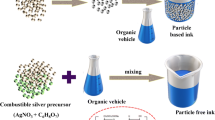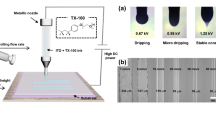Abstract
The fabrication of printed electronic devices based on metal oxide inks requires the formulation of stable suspensions with specific fluidic properties. In our work, a tin oxide based solution was synthesized by aqueous sol–gel method and transformed into an ink with appropriate viscosity and surface tension to be inkjet-printed on polyimide foil and sintered at relatively low temperature. Thermal analysis by TGA/DSC and microstructural analysis by XRD of synthesized sol show that a crystallized structure of SnO2 could be obtained at 350 °C, which is lower than crystallization temperatures of SnO2 previously reported in the literature, and entirely consistent with the use of polyimide foil. The stability and the rheological properties of the ink were studied to ensure the jettability criteria of the inkjet printer. Electrical measurements of the printed sensing films were performed to characterize the response to CO gas in different concentrations, at working temperature of 300 °C.














Similar content being viewed by others
References
Khan S, Lorenzelli L, Dahiya RS (2015) Technologies for printing sensors and electronics over large flexible substrates: a review. IEEE Sens J 15:3164–3185
Yan C, Wang J, Wang X et al (2014) An intrinsically stretchable nanowire photodetector with a fully embedded structure. Adv Mater 26:943–950
Acuautla M, Bernardini S, Gallais L et al (2014) Ozone flexible sensors fabricated by photolithography and laser ablation processes based on ZnO nanoparticles. Sens Actuators B Chem 203:602–611
Uddin ASMI, Yaqoob U, Phan D-T, Chung G-S (2016) A novel flexible acetylene gas sensor based on PI/PTFE-supported Ag-loaded vertical ZnO nanorods array. Sens Actuators B Chem 222:536–543
Matindoust S, Baghaei-Nejad M, Shahrokh Abadi MH et al (2016) Food quality and safety monitoring using gas sensor array in intelligent packaging. Sens Rev 36:169–183
Wang C, Yin L, Zhang L et al (2010) Metal oxide gas sensors: sensitivity and influencing factors. Sensors 10:2088–2106
Neri G (2015) First fifty years of chemoresistive gas sensors. Chemosensors 3:1–20
Choi Y-J, Hwang I-S, Park J-G et al (2008) Novel fabrication of an SnO2 nanowire gas sensor with high sensitivity. Nanotechnology 19:095508. https://doi.org/10.1088/0957-4484/19/9/095508
Li C, Lv M, Zuo J, Huang X (2015) SnO2 highly sensitive CO gas sensor based on quasi-molecular-imprinting mechanism design. Sensors 15:3789–3800
Jimenez VM, Mejias JA, Espinós JP, González-Elipe AR (1996) Interface effects for metal oxide thin films deposited on another metal oxide II. SnO2 deposited on SiO2. Surf Sci 366:545–555
Fu C, Wang J, Yang M et al (2011) Effect of La doping on microstructure of SnO2 nanopowders prepared by co-precipitation method. J Non-Cryst Solids 357:1172–1176
Supothina S, Rattanakam R, Vichaphund S, Thavorniti P (2011) Effect of synthesis condition on morphology and yield of hydrothermally grown SnO2 nanorod clusters. J Eur Ceram Soc 31:2453–2458
Mosadegh Sedghi S, Mortazavi Y, Khodadadi A (2010) Low temperature CO and CH4 dual selective gas sensor using SnO2 quantum dots prepared by sonochemical method. Sens Actuators B Chem 145:7–12
Ma C, Sun X et al (2002) Preparation and characterization of SnO2 nanoparticles with a surfactant-mediated method. Nanotechnology 13:565. https://doi.org/10.1088/0957-4484/13/5/304
Zang Z, Nakamura A, Temmyo J (2013) Single cuprous oxide films synthesized by radical oxidation at low temperature for PV application. Opt Express 21:11448–11456
Zang Z, Tang X (2015) Enhanced fluorescence imaging performance of hydrophobic colloidal ZnO nanoparticles by a facile method. J Alloys Compd 619:98–101
Vidmar T, Topič M, Dzik P, Opara Krašovec U (2014) Inkjet printing of sol–gel derived tungsten oxide inks. Sol Energy Mater Sol Cells 125:87–95
Rieu M, Camara M, Tournier G et al (2016) Fully inkjet printed SnO2 gas sensor on plastic substrate. Sens Actuators B Chem 236:1091–1097
Brinker CJ, Scherer G (1990) Sol–gel science the physics and chemistry of sol–gel processing. Brinker, New York
Vallejos S, Gràcia I, Figueras E et al (2014) Microfabrication of flexible gas sensing devices based on nanostructured semiconducting metal oxides. Sens Actuators Phys 219:88–93
Dubourg G, Segkos A, Katona J et al (2017) Fabrication and characterization of flexible and miniaturized humidity sensors using screen-printed TiO2 nanoparticles as sensitive layer. Sensors 17:1854. https://doi.org/10.3390/s17081854
Yu X, Zhou N, Han S et al (2013) Flexible spray-coated TIPS-pentacene organic thin-film transistors as ammonia gas sensors. J Mater Chem C 1:6532–6535
Kumashiro Y, Nakako H, Inada M et al (2009) Novel materials for electronic device fabrication using ink-jet printing technology. Appl Surf Sci 256:1019–1022
Azzellino G, Grimoldi A, Binda M et al (2013) Fully inkjet-printed organic photodetectors with high quantum yield. Adv Mater 25:6829–6833
Eggenhuisen TM, Galagan Y, Biezemans AFKV et al (2015) High efficiency, fully inkjet printed organic solar cells with freedom of design. J Mater Chem A 3:7255–7262
Singh M, Haverinen HM, Dhagat P, Jabbour GE (2010) Inkjet printing-process and its applications. Adv Mater 22:673–685
Huang L, Huang Y, Liang J et al (2011) Graphene-based conducting inks for direct inkjet printing of flexible conductive patterns and their applications in electric circuits and chemical sensors. Nano Res 4:675–684
Derby B (2010) Inkjet printing of functional and structural materials: fluid property requirements, feature stability, and resolution. Annu Rev Mater Res 40:395–414
Köse H, Karaal Ş, Aydin AO, Akbulut H (2015) Structural properties of size-controlled SnO2 nanopowders produced by sol–gel method. Mater Sci Semicond Process 38:404–412
Hoeng F, Bras J, Gicquel E et al (2017) Inkjet printing of nanocellulose–silver ink onto nanocellulose coated cardboard. RSC Adv 7:15372–15381
Kaelble DH (1970) Dispersion-polar surface tension properties of organic solids. J Adhes 2:66–81
Owens DK, Wendt RC (1969) Estimation of the surface free energy of polymers. J Appl Polym Sci 13:1741–1747
Rudawska A, Jacniacka E (2009) Analysis for determining surface free energy uncertainty by the Owen–Wendt method. Int J Adhes Adhes 29:451–457
Bagheri-Mohagheghi M-M, Shahtahmasebi N, Alinejad MR et al (2008) The effect of the post-annealing temperature on the nano-structure and energy band gap of SnO2 semiconducting oxide nano-particles synthesized by polymerizing–complexing sol–gel method. Phys B Condens Matter 403:2431–2437
Ely F, Avellaneda CO, Paredez P et al (2011) Patterning quality control of inkjet printed PEDOT:pSS films by wetting properties. Synth Met 161:2129–2134
Bizi-Bandoki P, Benayoun S, Valette S et al (2011) Modifications of roughness and wettability properties of metals induced by femtosecond laser treatment. Appl Surf Sci 257:5213–5218
Lu Q-H, Li M, Yin J et al (2001) Polyimide surface modification by pulsed ultraviolet laser irradiation with low fluence. J Appl Polym Sci 82:2739–2743
Hench LL, West JK (1990) The sol-gel process. Chem Rev 90:33–72
Shiomi H, Kakimoto C, Nakahira A, Takeda S (2000) Preparation of SnO2 monolithic gel by sol-gel method. J Sol Gel Sci Technol 19:759–763
Kadhim IH, Abu Hassan H (2015) Effects of glycerin volume ratios and annealing temperature on the characteristics of nanocrystalline tin dioxide thin films. J Mater Sci: Mater Electron 26:3417–3426
Lee WP, Routh AF (2004) Why do drying films crack? Langmuir 20:9885–9888
Jin Z, Zhou H-J, Jin Z-L et al (1998) Application of nano-crystalline porous tin oxide thin film for CO sensing. Sens Actuators B Chem 52:188–194
Tiemann M (2007) Porous metal oxides as gas sensors. Chem Eur J 13:8376–8388
Tamaki J, Miyaji A, Makinodan J et al (2005) Effect of micro-gap electrode on detection of dilute NO2 using WO3 thin film microsensors. Sens Actuators B Chem 108:202–206
Lee S (2017) Electrodes for semiconductor gas sensors. Sensors 17:683. https://doi.org/10.3390/s17040683
Author information
Authors and Affiliations
Corresponding author
Ethics declarations
Conflict of interest
The authors declare that they have no conflict of interest.
Rights and permissions
About this article
Cite this article
Kassem, O., Saadaoui, M., Rieu, M. et al. Synthesis and inkjet printing of sol–gel derived tin oxide ink for flexible gas sensing application. J Mater Sci 53, 12750–12761 (2018). https://doi.org/10.1007/s10853-018-2577-9
Received:
Accepted:
Published:
Issue Date:
DOI: https://doi.org/10.1007/s10853-018-2577-9




